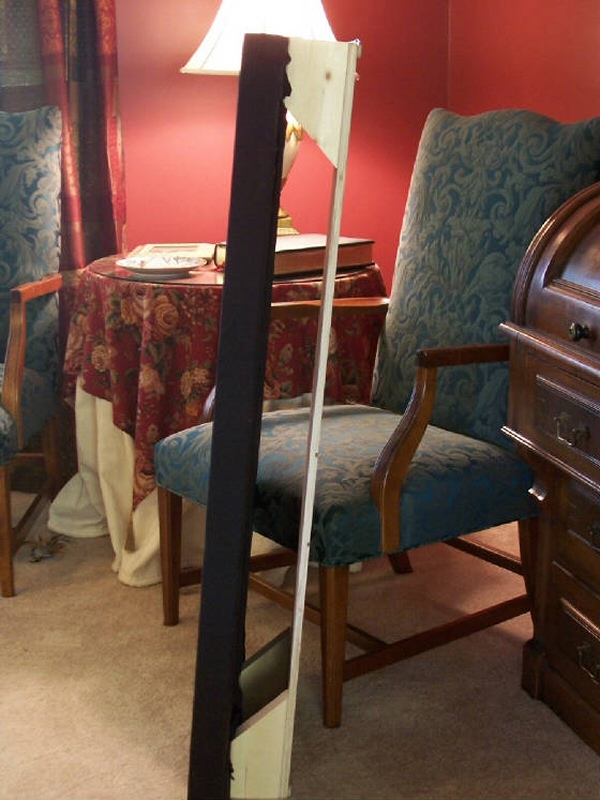 |
VO-BB - 19 YEARS OLD!
Where A.I. is a four-letter word.
|
| View previous topic :: View next topic |
| Author |
Message |
Zach Meissner
Contributor IV

Joined: 01 Feb 2013
Posts: 132
Location: Husker Nation aka Nebraska
|
 Posted: Fri May 23, 2014 12:23 pm Post subject: Is compressing denim insulation OK? Posted: Fri May 23, 2014 12:23 pm Post subject: Is compressing denim insulation OK? |
 |
|
I'm a big fan of the UltraTouch Denim insulation for acoustic treatment. I've built several panels out of it and am quite happy with the results.
The only drawback is they are 3.5" thick, so my current panels are 1x4's hanging on the wall, which is fine, but i'm wanting to hang them on the ceiling, which will look rather unsightly for my space - the basement we actually use.
I'm curious if i compressed is down to an inch or so if that would affect the sound absorption quality. I'd rather not buy the OC 703 panels bc I have a lot of denim left over to use still.
Anyone have experience with this?
_________________
Pax vobiscum
ZachMeissner.com |
|
| Back to top |
|
 |
Lizden
A Zillion

Joined: 04 Dec 2006
Posts: 8856
Location: The dark recesses of my mind
|
 Posted: Fri May 23, 2014 12:47 pm Post subject: Posted: Fri May 23, 2014 12:47 pm Post subject: |
 |
|
I am NOT an acoustic engineer,
but since you are using it for acoustic purposes and no insulation purposes I don't see why not.
You shouldn't compress it when using it for insulation, I get that, but in this case it's mass so.....
But again....one of the acoustic guys would probably know better.
_________________
Liz de Nesnera O.A.V. ~ Livin' The VO Dream!
English/French Bilingual VO w/ ISDN
HireLiz.com / liz@hireliz.com |
|
| Back to top |
|
 |
Rob Ellis
M&M

Joined: 01 Aug 2006
Posts: 2385
Location: Detroit
|
 Posted: Fri May 23, 2014 1:03 pm Post subject: Posted: Fri May 23, 2014 1:03 pm Post subject: |
 |
|
| I'm no engineer either, but I suspect that compressing it may indeed affect how it absorbs sound.....paging Frank, George, vkuehn..... |
|
| Back to top |
|
 |
todd ellis
A Zillion

Joined: 02 Jan 2007
Posts: 10493
Location: little egypt
|
 Posted: Fri May 23, 2014 1:52 pm Post subject: Posted: Fri May 23, 2014 1:52 pm Post subject: |
 |
|
in lieu of frank, george or vkuehn --- i would say - yes - compression will affect the absorption --- i would think that it would HAVE to.
_________________
"i know philip banks": todd ellis
who's/on/1st?
 |
|
| Back to top |
|
 |
Jason Huggins
The Gates of Troy

Joined: 12 Aug 2011
Posts: 1846
Location: In the souls of a million jeans
|
 Posted: Fri May 23, 2014 1:55 pm Post subject: Posted: Fri May 23, 2014 1:55 pm Post subject: |
 |
|
There was a study done that showed that thickness has a direct correlation with the absorption of low frequencies. That would mean (in theory) that if you compress the material, it would be thinner, and thus not absorb low frequencies as effectively. I doubt it would have an effect on anything but the low frequencies, since you can stop the other frequencies with 2" foam that isn't very dense. It's the low end I would be concerned about. Given proper bass traps though, you might not need to worry too much about the ceiling (I mean as far as compressing the material. You would still need something on the ceiling). I'm just theorizing here though.
Here is an interesting read:
Sound Absorption Factors
You can easily build cloud panels that don't look hideous. My ceiling is covered, and it doesn't seem to be an eyesore to me  |
|
| Back to top |
|
 |
Lee Gordon
A Zillion

Joined: 25 Jul 2008
Posts: 6844
Location: West Hartford, CT
|
 Posted: Fri May 23, 2014 2:38 pm Post subject: Posted: Fri May 23, 2014 2:38 pm Post subject: |
 |
|
I'm no acoustical engineer, but I'll bet Liz is correct.
_________________
Lee Gordon, O.A.V.
Voice President of the United States
www.leegordonproductions.com
Twitter: @LeeGordonVoice
 |
|
| Back to top |
|
 |
Scott Lyle
Contributor IV

Joined: 27 Jul 2010
Posts: 109
Location: Greensboro, NC, home of the ACC
|
 Posted: Fri May 23, 2014 5:18 pm Post subject: Posted: Fri May 23, 2014 5:18 pm Post subject: |
 |
|
What about if, instead of compressing it, you arranged the panels in a way that would give the ceiling a pleasing look. For instance, if you have 2'x4' panels, you could gang them together and make a 4'x4' square. Then you could arrange them in a grid pattern to perhaps give your ceiling a coffered ceiling effect. You could cover each of the 4'x4' squares with just one piece of fabric to tie it together visually.
Good luck with it.
Scott |
|
| Back to top |
|
 |
vkuehn
DC

Joined: 24 Apr 2013
Posts: 688
Location: Vernon now calls Wisconsin home
|
 Posted: Fri May 23, 2014 7:06 pm Post subject: Posted: Fri May 23, 2014 7:06 pm Post subject: |
 |
|
For what most of us are doing, we can violate the text-book "rules" or the text-book "science" and still come out with a room that works well. I have followed this subject for more years than I want to admit, and have seen the advice change over the years as we have more people with engineering training participating in art. I have found one of the great sources today for understanding the topic is to hang out with some of the consultants who plan the acoustics for houses of worship. The older buildings served earlier styles of how people do worship, but this modern new Mega-church crowd requires a whole new level of treating their "room". And a lot of consultants come in "clean up the room" after someone else tried their secret recipe which was... was... well... just a bunch of crap. You can "go to school" on their explanations of why the original didn't work and why their modification did work.
I'm going to contest what was stated earlier in this thread. If you want ACOUSTIC results, don't compress your material. The whole concept of most modern day acoustic treatment is having the sound go THROUGH the material, then through an air space between the material and the wal or ceiling, having the sound that made the journey THROUGH the foam or fiber bound off the wall and make it's way back through the foam or fiber on the way back into the room.
Note, the word used above is ACOUSTIC. If, however you are trying to achieve isolation from outside noise, doing what is called NOISEPROOFING, then you want MASS. Then you might want to compress your material so that each square foot or cubic foot of material is more dense.
I've never seen or touched the denim material. Could you cut the panels of denim so instead of being 3 or 4 inches thick, they are 1-1/2 to 2 inches thick? I assume you were trying to not lower your ceiling or make the booth interior dimensions too small by eating up a full four inches of thickness. If you choose to leave the air space between the panels you construct (which is rather universally recommended) then you have to think of those panels being about SIX INCHES thick counting that dead space.
No one is going to come out and use exotic instruments to measure what you have achieved. If you do what the text book seems to indicate is the WRONG thing to do, but in the end you get the sound you were looking for, what problem is there to fear. I suggest temporarily mounting your panels and making some test recordings before doing a permanent mount. All of my panels are mounted using a lift off cleat or clip approach so I can put them up, take them down and move them around until I know I am going to be happy with their thickness, density and location.
I think the Home Theater contractors and designers have in some ways set a style and standard. A lot of people have been to someone's house and experienced a "knock your socks off" install that could be on the cover of a industry trade magazine. But doesn't mean their style is the most effective.. it may be just the most attractive. If you are thinking about how your studio will look if you publish pictures on your website, the "skin-tight" home theater style looks really slick and polished to the amateurs, but if real studio people are looking at your website and they see your panels that are spaced away from the wall, they will see that as a professional install... even though it looks crude to the non-acoustical crowd. |
|
| Back to top |
|
 |
georgethetech
The Gates of Troy

Joined: 18 Mar 2007
Posts: 1877
Location: Topanga, CA
|
 Posted: Fri May 23, 2014 9:29 pm Post subject: Posted: Fri May 23, 2014 9:29 pm Post subject: |
 |
|
In theory, a more compressed (read dense) material will be more effective at absorbing low frequencies and less so at higher frequencies. OC705 is more dense than OC703 so it is preferred (and used) in bass traps from Auralex.
What's the worst thing that could happen if you try it? How do you plan to compress them?
Then again you can always use this stuff:
http://www.atsacoustics.com/recycled-cotton-batts.html
_________________
If it sounds good, it is good.
George Whittam
GeorgeThe.Tech
424-226-8528
VOBS.TV Co-host
TheProAudioSuite.com Co-host
TriBooth.com Co-founder |
|
| Back to top |
|
 |
Jason Huggins
The Gates of Troy

Joined: 12 Aug 2011
Posts: 1846
Location: In the souls of a million jeans
|
 Posted: Sat May 24, 2014 7:20 am Post subject: Posted: Sat May 24, 2014 7:20 am Post subject: |
 |
|
Well according to the research put into the science journal article: Effects of compression on sound absorption of transversely isotropic fibrous materials at oblique incidence, "The obtained results indicate that increases in compression ratio usually decrease the absorption coefficient in the low and medium frequency region, whereas for high frequencies, compression improves the absorption coefficient or has no effect. "
I agree that at the same thickness, a denser material would absorb low frequencies better, but in this case it wouldn't be.
Though it would be denser, there are other variables at play. There is an equal density to thickness ratio, so the sound wave will theoretically contact the same amount of fibrous material, but over a different timeline.
But REALLY you probabaly wouldn't be able to tell much of a difference if the rest of the room was properly treated. Why not just use thinner and denser material to begin with?
HOW you compress would definitely be a big question. If you use anything rigid, that would negate the entire discussion, because it would reflect sound instead of absorb it. If you used fabric, it would be hard to get it to look good. |
|
| Back to top |
|
 |
Bruce
Boardmeister

Joined: 06 Jun 2005
Posts: 7926
Location: Portland, OR
|
 Posted: Sat May 24, 2014 9:14 am Post subject: Posted: Sat May 24, 2014 9:14 am Post subject: |
 |
|
To reiterate in simple fashion, acoustic material works because the holes in the material let the sound in where it can then be trapped in all the nooks and crannies in the material. That's why you put a fabric full of holes, such as burlap, on the outside of any panel you make. It lets the sound go through into the material. Compress the material and you have less space for trapping.
B
_________________
VO-BB Member #31 Enlisted June, 2005

I'm not a Zoo, but over the years I've played one on radio/TV. . |
|
| Back to top |
|
 |
Zach Meissner
Contributor IV

Joined: 01 Feb 2013
Posts: 132
Location: Husker Nation aka Nebraska
|
 Posted: Sat May 24, 2014 1:09 pm Post subject: Posted: Sat May 24, 2014 1:09 pm Post subject: |
 |
|
Thanks for the input everyone.
I'm currently recording into a corner with a panel on each side and a small 2'x2' cloud above it. It's looks good being nice and contained and works fairly well. My problem is the secondary reflections coming from behind me.
Vkuehn, is this the configuration you are referring to? Panel then space behind panel.

I've never seen that before.
I was thinking about compressing it by laying down either muslin or canvas on the floor first, then placing the denim batts on top of it, cut to length and width. On top of the denim i would place a thin, ~1/4", piece of plywood, and pull tight the fabric around the edge and pressure on the plywood, staple the fabric to the wood.
Here's an audio sample I recorded if it helps to get a better idea of what the situation is, which I think are secondary reflections: http://bit.ly/1hgEIV8
_________________
Pax vobiscum
ZachMeissner.com |
|
| Back to top |
|
 |
vkuehn
DC

Joined: 24 Apr 2013
Posts: 688
Location: Vernon now calls Wisconsin home
|
 Posted: Sat May 24, 2014 9:24 pm Post subject: Posted: Sat May 24, 2014 9:24 pm Post subject: |
 |
|
| Zach Meissner wrote: |
I'm currently recording into a corner with a panel on each side and a small 2'x2' cloud above it. It's looks good being nice and contained and works fairly well. My problem is the secondary reflections coming from behind me.
Vkuehn, is this the configuration you are referring to? Panel then space behind panel.
|
Yes, if I am interpreting the picture correctly. Your "stand-offs" in the picture would put more space between the panel and the wall than I would in a small room. SoundGun talked about the density of your foam or fabric changing whether the lower frequencies or upper frequencies were trapped more. My memory is that maybe the depth of the empty space behind the panel can also determine which frequencies are affected most.
| Zach Meissner wrote: |
I was thinking about compressing it by laying down either muslin or canvas on the floor first, then placing the denim batts on top of it, cut to length and width. On top of the denim i would place a thin, ~1/4", piece of plywood, and pull tight the fabric around the edge and pressure on the plywood, staple the fabric to the wood.
|
Are you saying that if you followed the construction description above, that the sound would first enter the fabric covering, then enter the denim material, and then hit the quarter inch plywood which for all practices it cannot enter, and then what little sound was able to go through the plywood would hit the dead-space between all this mechanism and the wall?
I don't have the skill-set to give you an answer based on calculations, but I personally would NOT want a barrier immediately behind the foam or denim or other absorbent material.
Some additional thoughts. CORNERS are a bear!!!! I will go to extreme actions to keep from talking into a corner. Is this a standing or sitting position for using a mic?
Is there a desk surface involved?
You could be dealing not only with *** a *** corner but three corners. One is where the two wall butt together. The second is where the wall to your right butts up against either the ceiling or the floor, and the third is where the wall to your left butts up against either the ceiling or the floor.
Take a portable radio and set it in the middle of the floor and set the listening volume. Then move the radio from the center of the room and move it so that it sits on the floor and is backed up against a wall. Then move the radio to the corner where the two walls and the floor all come together. The volume of the sound of the radio will probably make a noticeable change with each move, the tonality of the sound of the radio will probably make a noticeable change with each move.
When you move your mic to similar locations, the level of your voice and the tonality of your voice will change. Young male radio announcers in years gone by learned to use this phenomena to make their voice sound as though it had been well seasoned by years of Marlboros and Jim Beam.
I do not have "golden ears" in judging vocal samples, but after playing with the audio sample you posted, I conclude that you *** may *** be hearing the corner effect rather than slap-back from behind you.
Experiment. |
|
| Back to top |
|
 |
vkuehn
DC

Joined: 24 Apr 2013
Posts: 688
Location: Vernon now calls Wisconsin home
|
 Posted: Sat May 24, 2014 9:36 pm Post subject: Posted: Sat May 24, 2014 9:36 pm Post subject: |
 |
|
Further thoughts- My friends who design spaces for a living tell me that many of the rules and rules-of-thumb that we quote and read about assume a room of significant size.
Spaces that we tend to dedicate to voice-over recording are so small that what is standard practice in a music performance space or a worship space or a large conference room just don't work. Virtually no one in the business ever unpacks the delicate and expensive audio measuring devices to tune a 10 x 12 room, much less a venue the size of a Whisper Room sized space. Who is going to pay a well equipped consultant six to ten thousand dollars to "tune" a room you hope to construct for $4,000 or less.
Put those numbers into perspective. If you buy $120 worth of stuff at Home Depot and when you put it in place it does not achieve what you wanted, throwing it out and trying plan B doesn't sound so costly does it. |
|
| Back to top |
|
 |
georgethetech
The Gates of Troy

Joined: 18 Mar 2007
Posts: 1877
Location: Topanga, CA
|
 Posted: Sun May 25, 2014 1:55 pm Post subject: Posted: Sun May 25, 2014 1:55 pm Post subject: |
 |
|
Yep, I've learned over the last 10 years that these tiny booths you work in have their own sets of rules that really are unique to VO. Adding more angles or diffusion in these tiny rooms isn't helpful at all. While I've mastered tuning VO booths, I'd never try to fool someone into thinking I can tune a control room or larger music recording studio with the same success. I learned a lot from late Mike Sommer, as well, that it's VERY hard to over-treat a small booth. To make any room in a typical house truly "anechoic" you'd have no room left to stand in there with 3' thick of treatment on the walls.
_________________
If it sounds good, it is good.
George Whittam
GeorgeThe.Tech
424-226-8528
VOBS.TV Co-host
TheProAudioSuite.com Co-host
TriBooth.com Co-founder |
|
| Back to top |
|
 |
|
|
You cannot post new topics in this forum
You cannot reply to topics in this forum
You cannot edit your posts in this forum
You cannot delete your posts in this forum
You cannot vote in polls in this forum
|
Powered by phpBB © 2001, 2005 phpBB Group
|







